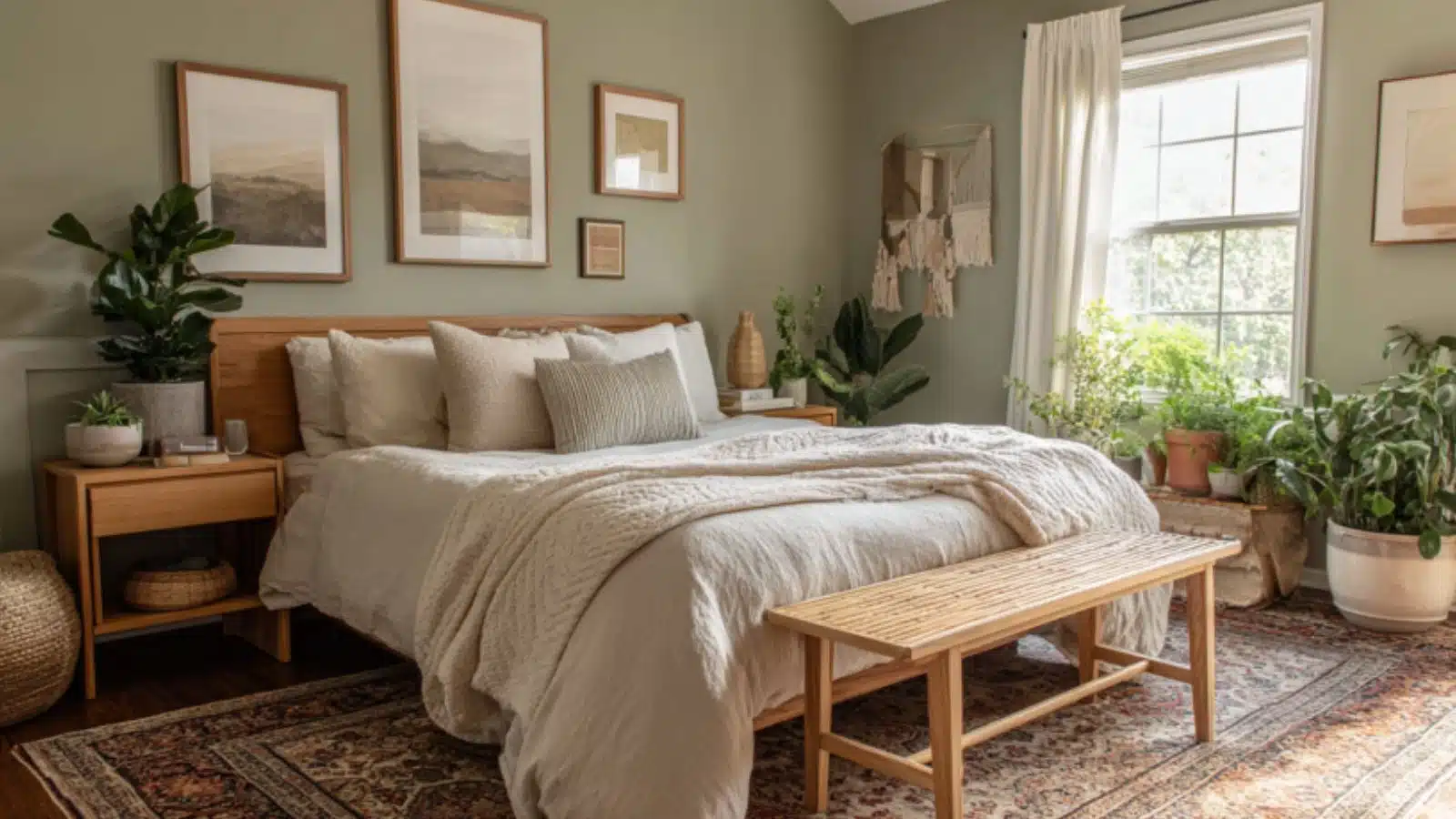Cozy Master Bedroom Decor Ideas for Creating a Relaxing Retreat
Table of Contents
Have you ever wondered why certain bedrooms feel instantly calming as soon as you step inside? Maybe it’s the plush textures, the soft glow of lamps, or simply the inviting layout. In today’s fast-paced world, our master bedrooms need to be more than just places to sleep—they should serve as tranquil retreats, offering genuine respite from daily stress.
Studies have shown that the design of our sleeping environment can significantly impact relaxation and sleep quality. A cozy, well-curated master bedroom can reduce cortisol levels, boost mood, and improve rest. But creating that sanctuary-like feel often requires thoughtful design—starting with the right textures, lighting, color palette, and layout.
In this article, we’ll explore seven master bedroom decor ideas aimed at infusing warmth, comfort, and style into your space. You’ll find practical guidance on choosing paint colors, layering textiles, enhancing lighting, incorporating nature, selecting furniture, adding personal touches, and maintaining balance. Two sections—layering textiles and lighting design—are expanded with extra tips and visuals to help you recreate that dreamy escape. By the end, you’ll be equipped with the inspiration and know-how to transform your room into a relaxing retreat.
Start with a Soothing Color Palette
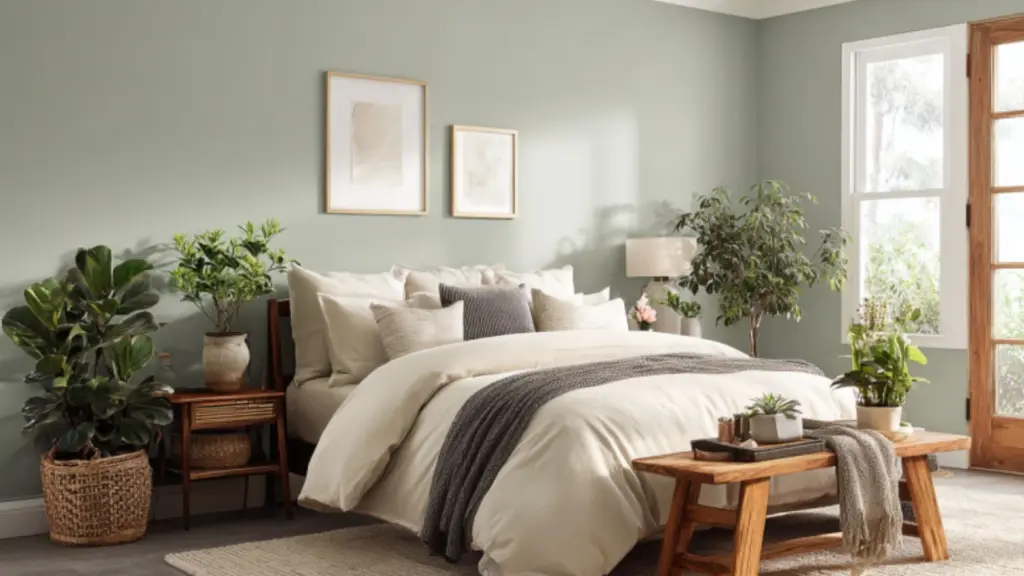
When designing a cozy master bedroom, the color palette lays the foundation for mood and atmosphere. Softer, muted tones—think blush neutrals, gentle grays, sage greens, or warm taupes—create an understated elegance that feels restful yet stylish. These shades work especially well under low lighting, subtly reflecting light to enhance the overall ambiance.
Accent walls can add a layer of depth without overwhelming the space. A velvety charcoal behind the bed or a dusty blue tone can make decor and bedding pop while retaining that sense of calm. Matching these tones across bedding, curtains, and accent pieces creates cohesion and makes the room feel intentionally designed.
Color Palette Choices
| Base Color | Accent Tone | Mood Achieved | Styling Tip |
|---|---|---|---|
| Warm Beige | Earthy Taupe | Cozy and grounded | Add wooden frames and wicker decor |
| Soft Gray | Warm Blush | Balanced and refined | Use plush rugs in neutral tone |
| Sage Green | Cream or Oatmeal | Nature-inspired calm | Introduce houseplants |
| Dusty Blue | Navy or Charcoal | Serene with subtle drama | Pair with white linens |
Layer Luxe Textures for Visual and Physical Comfort
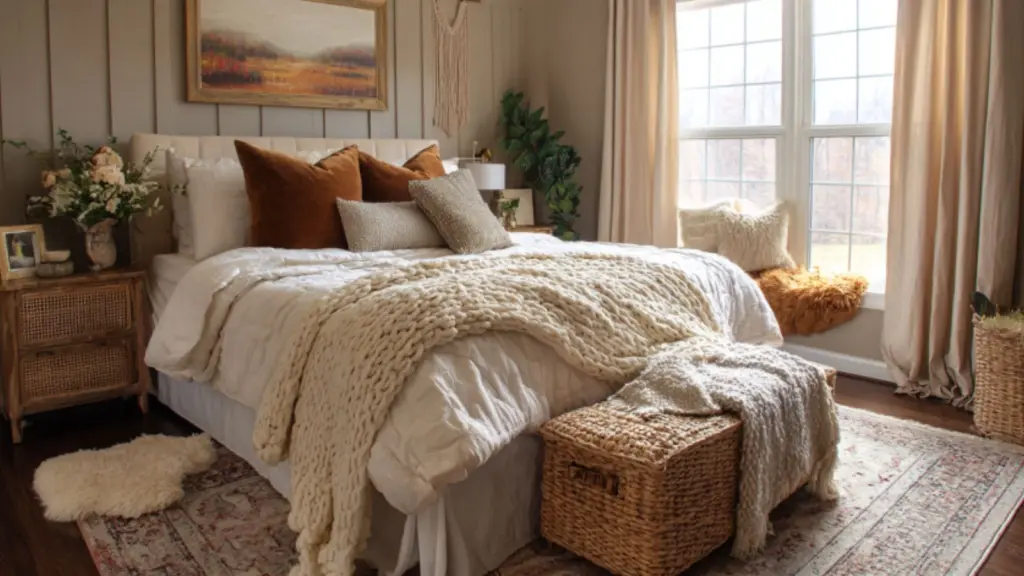
Textures elevate a cozy bedroom from basic to deeply inviting. The key is creating a tactile experience wherever the eye lands—from under your feet to above your head.
Mixed Bedding and Throws
Layer linen sheets with a cotton duvet and a velvet throw. Introduce pillows in suede, chunky knit, and faux fur; each adds a distinct tactile element and visual depth.
Rugs Underfoot
A plush rug provides softness and warmth on colder mornings, while woven rugs bring natural texture. Anchor the bed and sitting area to define zones and enhance coziness.
Window Treatments That Comfort
Thick linen blackout curtains offer privacy and insulation, while sheer panels ensure a soft glow during the day. The combo feels layered, elegant, and restful.
Furniture and Accent Textiles
Complement smooth wood or leather nightstands with woven baskets, wool poufs, and chaise seating upholstered in boucle. These softer accents balance clean lines and create dimension.
Texture Layering Cheat Sheet
| Element | Texture Type | Why It Works |
|---|---|---|
| Bedding & Pillows | Velvet, knit, suede, cotton | Creates tactile variety and softness |
| Rugs | Plush wool, woven jute | Defines areas, anchors furniture |
| Curtains | Linen blackout + sheer panels | Offers light control and warmth |
| Furniture Accents | Boucle upholstery, wicker | Softens edges, enhances depth |
By combining multiple textures, your bedroom becomes a sanctuary for both the senses and the soul. Each layer invites you to linger just a moment longer.
Use Lighting to Set a Relaxing Ambience
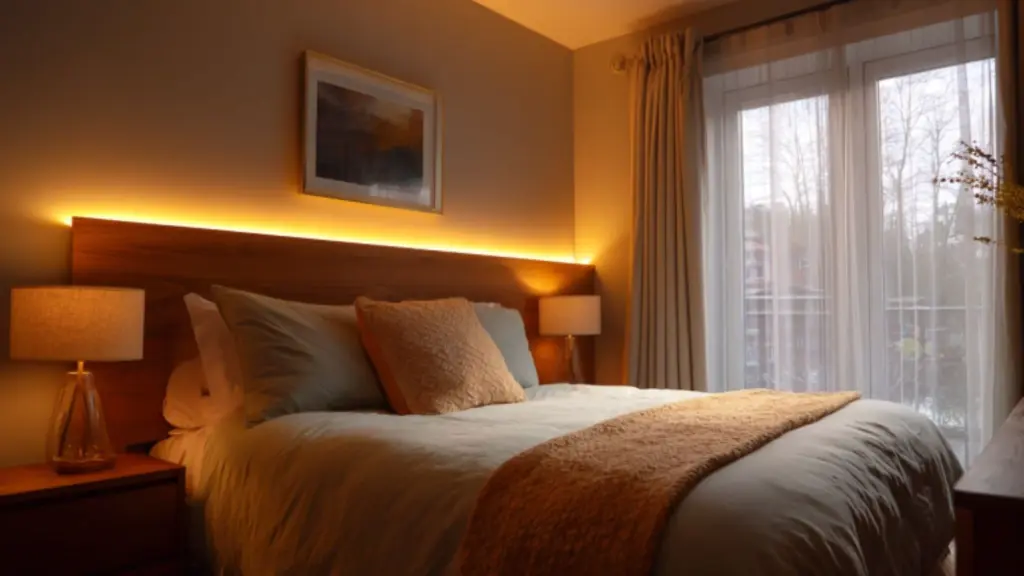
Lighting is the secret ingredient that transforms a bedroom from ordinary to exceptionally cozy. When layered correctly, it creates depth and warmth that make the space feel both calming and luxurious.
Layering Light: Ambient, Task, Accent
Start with soft overhead lighting—think recessed LED with dimmers or fabric-shaded ceiling fixtures. Then add bedside lamps with warm bulbs (2700K or lower) for reading and relaxation. Finally, add accent lighting—candles, fairy lights, or LED strips behind the headboard—to complete the mood.
Warm vs. Cool Lighting
Stick with warm-toned light sources. Cool, blue-toned bulbs can make the space feel clinical or cold. Opt instead for amber or golden-toned lights that promote relaxation and comfort.
Smart Controls
Dimmers and smart bulbs allow for easy adjustment. Begin your evening with brighter light while winding down, then fade to soft, candle-like glow as bedtime approaches.
Sample Lighting Layout
| Lighting Tier | Function | Suggested Fixture Type |
|---|---|---|
| Ambient | Overall illumination | Dimmed overhead lights, wall sconces |
| Task | Reading, dressing, bedside use | Table lamps, adjustable wall sconces |
| Accent | Mood and warmth | Candles, LED strips, fairy lights |
With careful lighting, your bedroom becomes a live-in retreat. Switching lighting layers throughout the evening enhances both comfort and design, guiding you gently from day to night.
Anchor the Bed with Statement Headboards and Nightstands
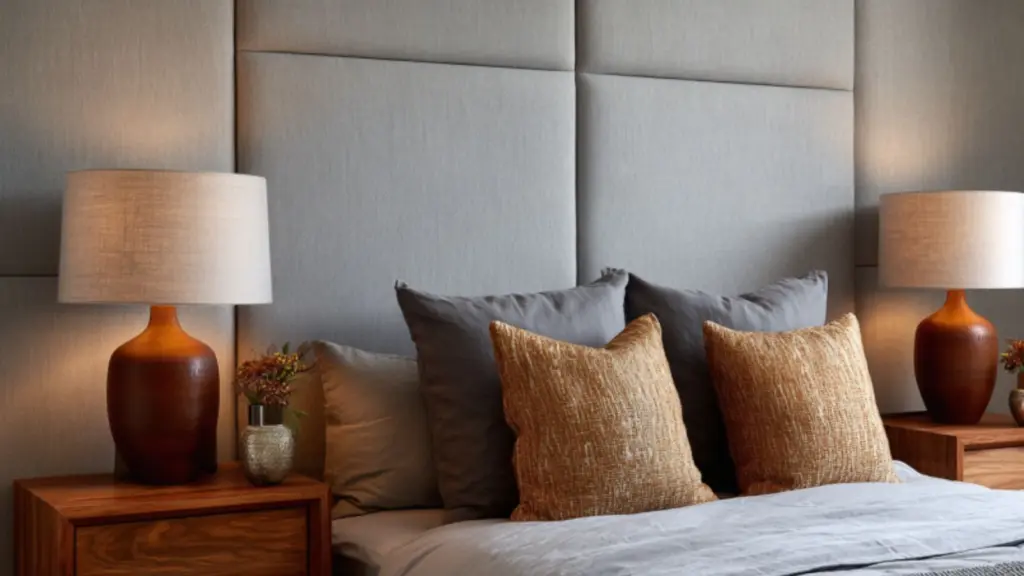
A headboard acts as both a visual anchor and a comfort feature. Opt for upholstered designs in velvet or linen to enhance softness. Tall wood slatted headboards add sophistication while tying in natural texture.
Nightstands should be equal parts function and beauty. Slim tables in wood or marble—paired with drawers or trays—offer storage for books, remotes, and essentials. Bundle bedside accessories like minimal lamps, ceramic coasters, or small stack of books for an inviting and personalized look.
Bed-Centering Essentials
| Design Element | Role | Design Tips |
|---|---|---|
| Upholstered Headboard | Softness, visual focus | Choose rich fabric or tone-on-tone |
| Wooden Slatted Headboard | Texture, structure | Match bedside wood finishes |
| Nightstand | Storage + surface accessory space | Keep surfaces neat with trays |
| Personal Touches | Functional styling and warmth | Use ceramics, books, clipped florals |
Position the bed centrally, leaving uniform spacing on each side to create visual symmetry. A well-styled headboard and nightstands shape the bedroom’s focal point, making your sanctuary feel purposeful.
Integrate Nature for a Calming Connection
Bringing natural elements into the master bedroom has restorative and design benefits. Plants enhance air quality and infuse a sense of serenity while natural materials reinforce the organic aesthetic.
Indoor Greenery
Choose easy-care plants—rubber plants, fiddle leaf figs, or snake plants—that thrive in low to moderate lighting. Position them near windows or on clean-lined stands.
Natural Materials
Incorporate wood accents through flooring, frames, and furniture. Add stone accessories like river rock candles, geode bookends, or marble trays to bring subtle grounding energy.
Views and Visual Connection
If you have a window view, drape curtains to frame the outdoors without obstructing the scenery. Even small indoor gardens or terrarium bowls can offer a moment of nature in the midst of daily life.
Nature-Inspired Decor Breakdown
| Natural Element | Placement | Soothing Effect |
|---|---|---|
| Fiddle Leaf Fig | Corner near window | Softens room edges, adds height |
| River Rock Candle Tray | Nightstand or dresser | Adds organic visual focus |
| Wooden Bench | At foot of bed | Grounds the room with texture |
| Terrarium Bowl | Vanity or shelf | Miniature oasis, air-purifying |
By weaving natural elements into your design, your bedroom becomes part of the wider environment—a restful sanctuary where you can reconnect with nature each day.
Choose Furniture and Layout for Easy Flow
A relaxing bedroom should support movement and function effortlessly. Start with furniture selection geared toward comfort and structure—such as a reading chair, a low bench, or a sleek dresser.
Space is freed when you leave walkways clear and avoid overcrowding. A bedside bench or soft ottoman at the bed’s end creates small zones without locking in the layout. Ensure furniture scales to room size; oversized heads or multiple dressers overwhelm smaller spaces.
Furniture and Flow Planning
| Piece of Furniture | Function | Placement Tip |
|---|---|---|
| Reading Chair + Lamp | Cozy corner for winding down | Tuck near window or lamp |
| Bench or Ottoman | Foot-of-bed loading/unloading | Centered for symmetry |
| Low Dresser | Storage with tabletop styling | Against side wall for minimal footprint |
| Minimal Rug | Defines bed zone | Extends on all sides for balance |
Balance style and flow by leaving adequate space for movement—about 60 cm (24 inches) around the bed and furniture. This ensures ease and calm in your retreat.
Infuse Personality with Art and Personal Items
A bedroom’s cozy charm often lies in personal touches—pieces that reflect your taste and bring emotional resonance. Art, travel items, or family heirlooms can warm the space visually and emotionally.
Curated Wall Art
Hang a framed painting or favorite print above the headboard, balanced by bedside lamps. A small gallery wall opposite the bed can create a daily moment of reflection.
Textile Memories
Incorporate a handmade quilt or woven rug with sentimental value. Drape such items on benches or chairs to keep the heart of your story in view.
Scent and Sound
Add candles in ceramic vessels, hand-poured incense, or a sound machine for ambient background. These sensory details strengthen the sense of retreat.
Personal Styling Checklist
| Personal Element | Where to Place | Emotional Impact |
|---|---|---|
| Hand-Painted Art | Above bed or reading nook | Evokes calm or joy |
| Heirloom Quilt | Draped over bench or bed | Nostalgia and comfort |
| Ceramic Candle | Nightstand or dresser | Adds scent and visual interest |
| Framed Photo | On a hanging tray or shelf | Encourages fond memories |
Integrating personal decor ensures your bedroom is more than a designed space—it becomes a sanctuary that tells your story.
Maintain Clarity with Minimalist Styling
Even the coziest designs can collapse into clutter without restraint. The philosophy of minimalist styling ensures only curated items occupy your beautiful space.
Edit Regularly
Apply the “one-in, one-out” rule for decor. When you add a new piece, allow something else to rest or be gifted.
Open Surfaces
Keep nightstands and dressers visually calm—display one or two decorative items, leaving negative space around them.
Hidden Storage
Use baskets, boxes, or drawer organizers to keep essentials tucked away, preserving the visual serenity of the retreat.
Styling Clean Slate Checklist
| Area | Keep Minimal | Allow One or Two Accents |
|---|---|---|
| Nightstand | Clean surface | Vase, candle, small tray |
| Dresser | No stacks or piles | Single framed art, jewelry dish |
| Wall Spaces | No visual clutter | One focus piece or mirror |
| Floor Surface | No scattered clothes or items | Single rug with generous clearance |
By pruning excess items and focusing on intentional styling, your bedroom’s calmness remains constant, ensuring the retreat continues to nurture serenity.
Conclusion
Designing a cozy master bedroom is a journey, not an overnight fix. By applying soothing color palettes, layering textures, planning lighting thoughtfully, weaving in nature, and allowing space for personal touches, you can craft a room that supports rest and relaxation at every turn.
The key is balance: comfort balanced with restraint, warmth balanced with clarity, and personal expression balanced with structure. When all elements harmonize, your master bedroom becomes more than a room—it becomes your private retreat, ready to calm, inspire, and rejuvenate all who walk through the door.

